This page contains affiliate links, meaning we earn a small commission on your purchase at no additional cost to you. Thank you for helping to support Sarah’s Vegan Kitchen!
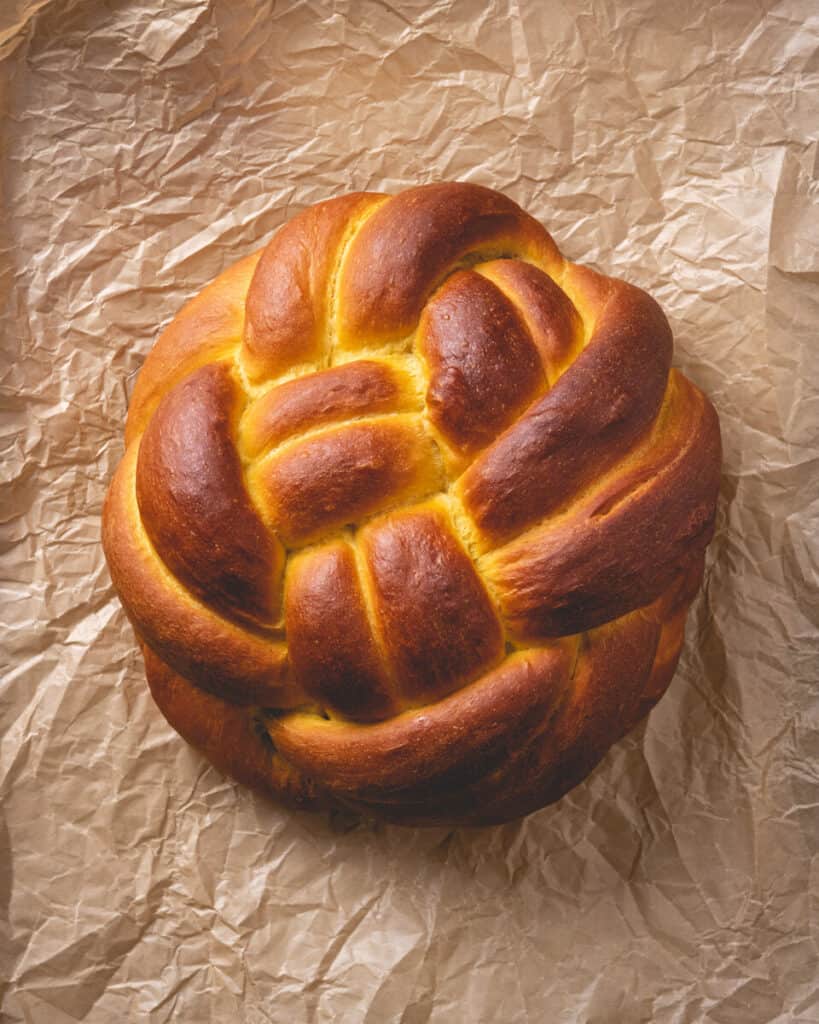
With Rosh Hashana (the Jewish New Year) approaching, I’m sharing one of my all-time favorite recipes for homemade bread. After a few years of experimentation, I’ve finally developed a recipe for vegan-friendly challah that tastes just as good as I remember.
Back when I lived in a co-op in college, I’d make a big batch of fresh bread for the house each weekend. I’d cycle through different recipes each week: pumpernickel, oat bread, honey wheat, or even baguettes if I was feeling ambitious. Usually I’d make about a dozen loaves for the house — except for when I was making challah. Then I’d make extra, because it would disappear fast.
What Is Challah?
Challah is a type of bread enjoyed as part of Jewish culture on the Sabbath and special holidays. The meaning of “challah” has evolved over time, but today we generally think of the kind of braided bread that’s sweet, soft and fluffy. The dough is enriched with eggs, which impart richness and challah’s signature golden color. Oftentimes it’s sweetened with honey, which in Jewish culture symbolizes the wish for a sweet year.
The Special Ingredient in my Vegan Challah
I have tried a few different egg replacements in my attempts to veganize challah, including: flaxseed, reduced aquafaba (the cooking liquid from chickpeas), and commercial vegan egg replacer like the Follow Your Heart Vegan Egg or Just Egg.
While each attempt yielded a very tasty loaf of bread, it was missing that something special that sets challah apart from a regular sweetened white bread — namely, the richness that egg yolks lend. That’s when an idea struck me.
Last fall, I had made a batch of sweet potato dinner rolls that were utter perfection. They were fluffy, buttery and tender, with the perfect hint of sweetness from the natural sugars in the sweet potato. The buns also had a beautiful golden hue to them, which I thought would be a nice touch in the challah dough to emulate the color of egg yolks.
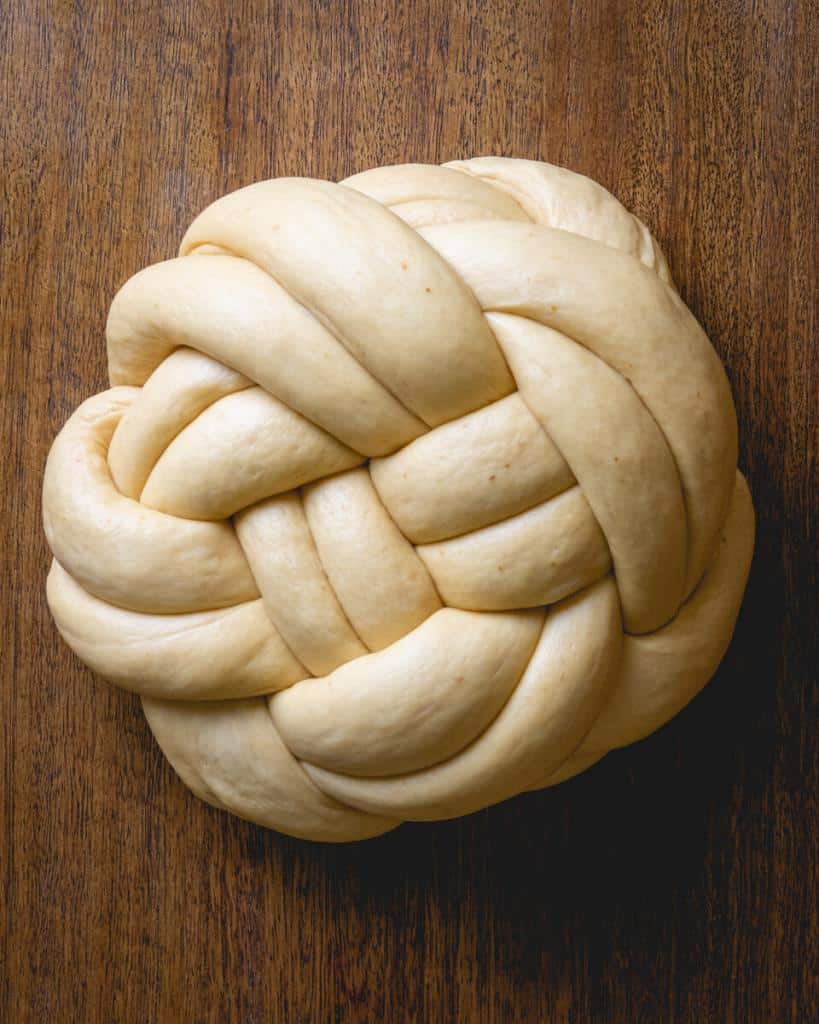
How to Make Sweet Potato Purée
For the vegan challah to have a smooth and uniform texture and appearance, you will need to use puréed sweet potatoes. If you simply mash the potatoes with a fork or potato masher, it won’t incorporate into the dough as seamlessly, and you will mostly have a regular white bread dough with flecks of sweet potato throughout. (I’ve already tried it, so let me save you the hassle.)
You can actually purchase sweet potato purée in a can at many grocery stores, which is the easiest option. However, you can also make it from scratch by simply processing cooked sweet potatoes in a food processor until completely smooth.
I like to peel, cube and boil my sweet potatoes until they almost fall apart when stuck with a fork. The softer they are when cooked, the easier it will be to get a nice smooth texture. I find boiling them gets them super soft very quickly, but you can use a different method of cooking them if you like, such as steaming, or roasting whole and then scooping out the flesh.
It is possible to use a blender if you don’t have a food processor, but it will take a bit more time and attention. You’ll have to regularly scrape down the sides of the pitcher to ensure that everything is blended evenly. If you have trouble with that, simply blend 1/2 cup (packed) cooked sweet potato with the 3/4 cup lukewarm water specified in the dough recipe. Use this mixture to proof the yeast and proceed with the recipe from there.
Ingredients for Vegan Challah
- Yeast — A packet of active dry or instant will work in this recipe.
- Butter — You can also use oil, but I like the richness that butter lends to this challah. Since traditionally the egg yolks in challah contribute a lot of fat, I like to add more fat to this recipe than I would to a standard white bread. It’s not quite as buttery as a brioche, however.
- Sweet Potato Purée — Our egg replacer. It adds a subtle sweetness and a pleasant golden hue, but there isn’t enough to make the bread taste like sweet potatoes. It keeps the dough moist and tender by disrupting the formation of gluten bonds that might make the dough overly tough or dense.
- Brown & White Sugar — I like the combination of the two, but you can feel free to add all of one or the other. Brown sugar retains more moisture and contributes a nice texture to the bread. It also has a hint of molasses in its flavor that adds some character that is a bit reminiscent of the flavor honey would typically contribute.
- Bread Flour — Of course! I haven’t tested this recipe with all-purpose flour, but I am sure it could be substituted in. You would probably just have to add some additional flour and work a little harder at kneading to achieve the right texture.
How to Make Vegan Challah
Step 1: Proof the Yeast
In the bowl of a stand mixer, sprinkle the yeast over the lukewarm water and allow it to proof for about 5 minutes, until foamy.
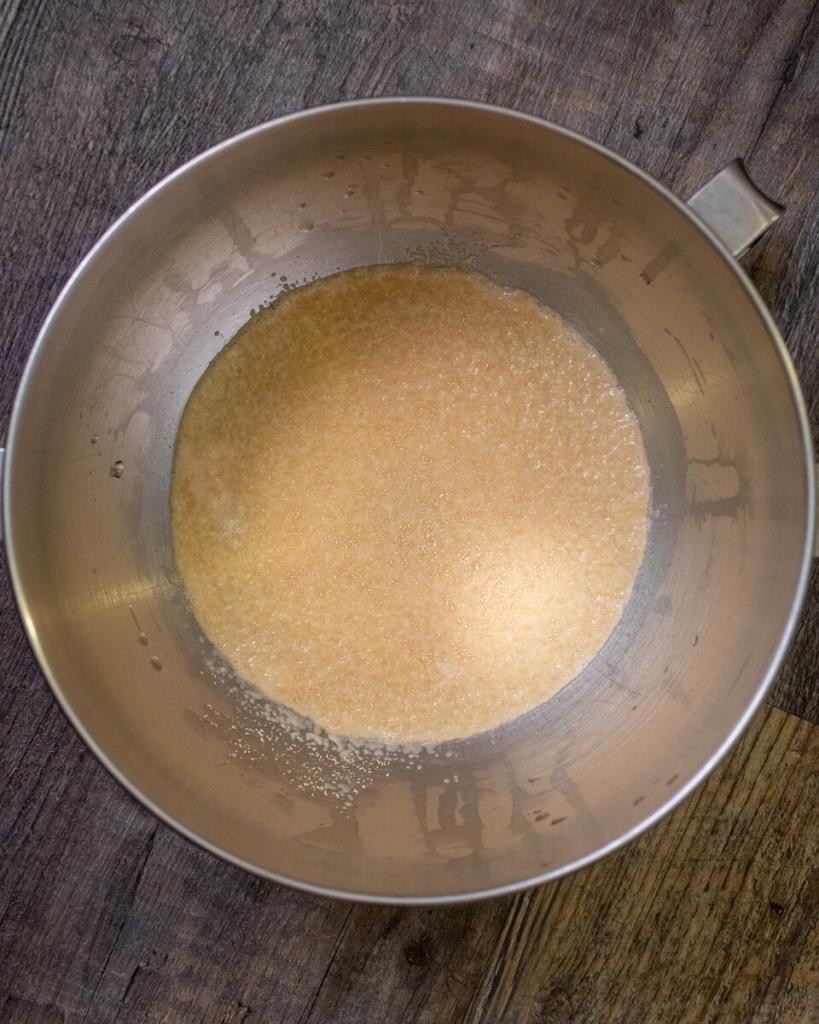
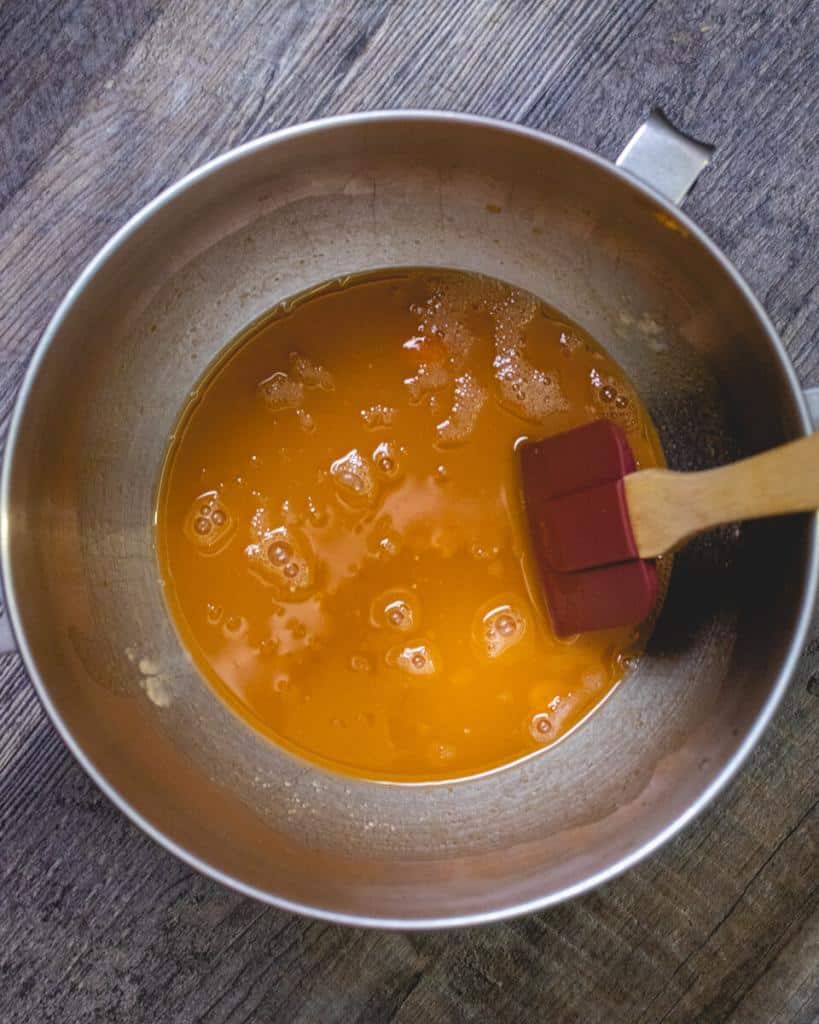
Step 2: Combine the Dough Ingredients
Add all the remaining ingredients to the bowl and mix on medium speed with the paddle attachment till the dough comes together in one rough mass.
Step 3: Knead the Dough
Switch to the dough hook attachment and allow it to knead the dough for 8-10 minutes on medium speed. If the dough seems excessively soft or sticky, add in extra flour an addition tablespoon at a time and allow the machine to knead it until incorporated. The dough should clear the sides of the bowl and become smooth and elastic. You are done kneading when it bounces back when poked.
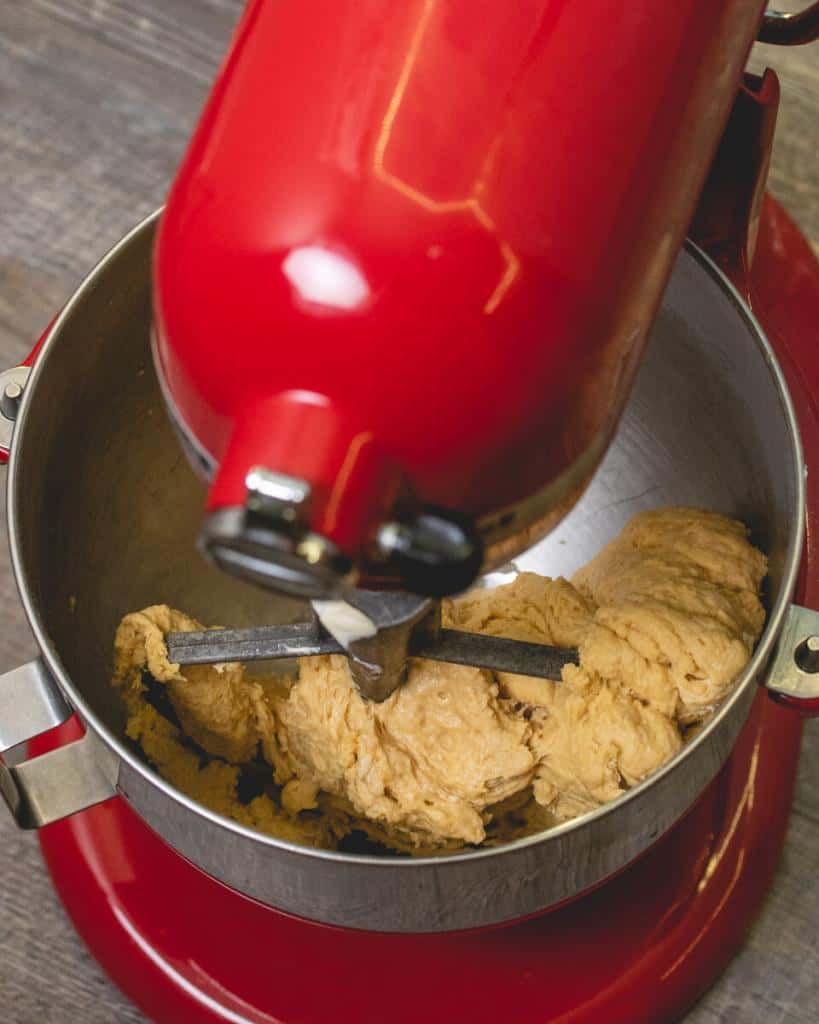
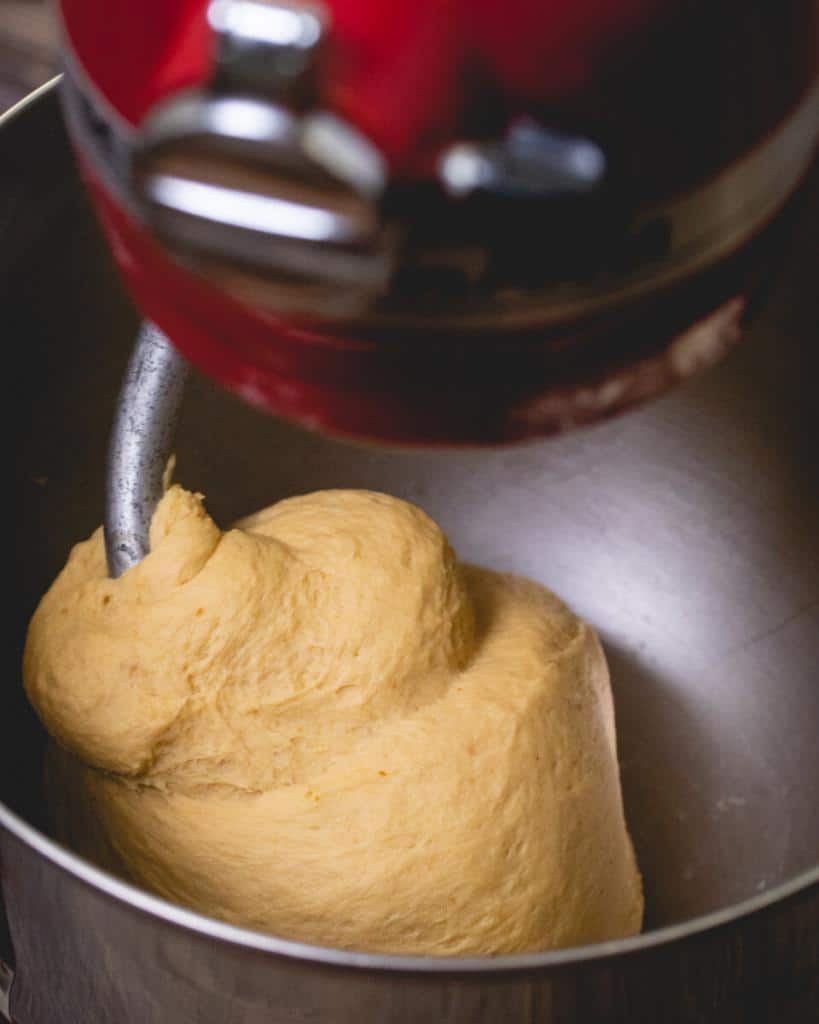
Step 4: Let the Dough Rise
Lift the dough out of the bowl and shape into a ball. Oil the bowl and put the dough back in, turning it over to coat with oil. Cover the bowl and let it rise in a warm place until roughly doubled in size. This typically takes about an hour, but will go faster if it’s particularly warm. If it’s the wintertime and your kitchen is particularly cold, you can let it rise in the oven with the oven light on to keep it warm.
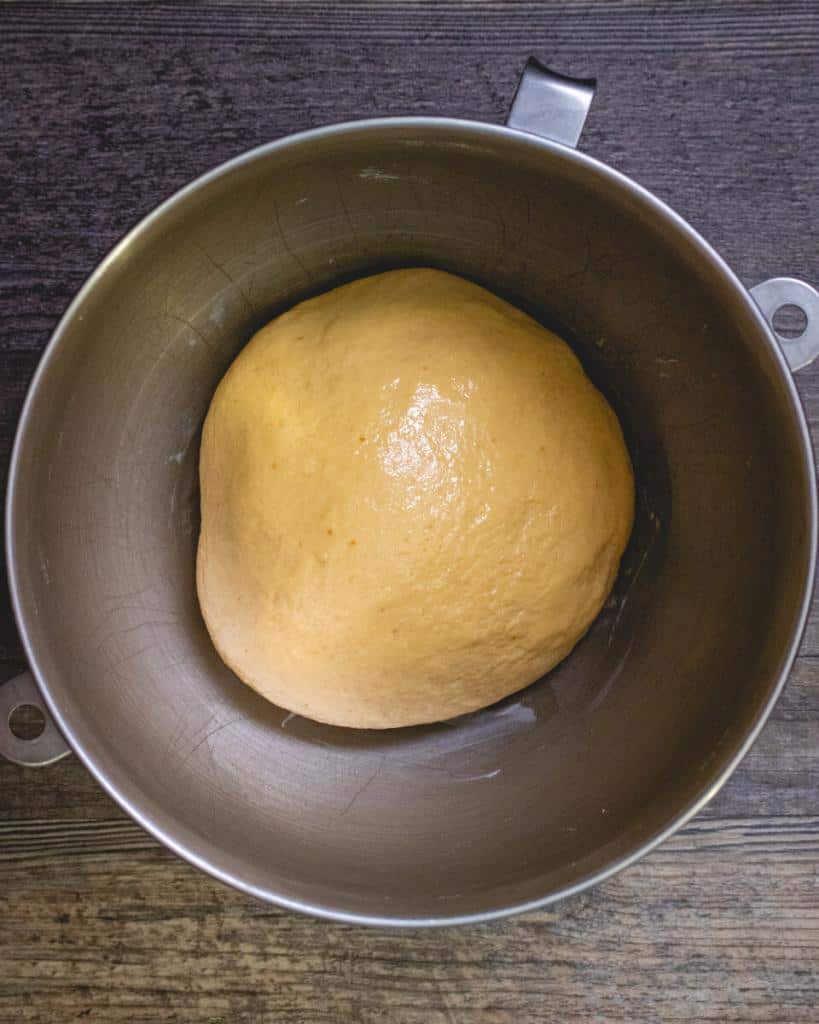
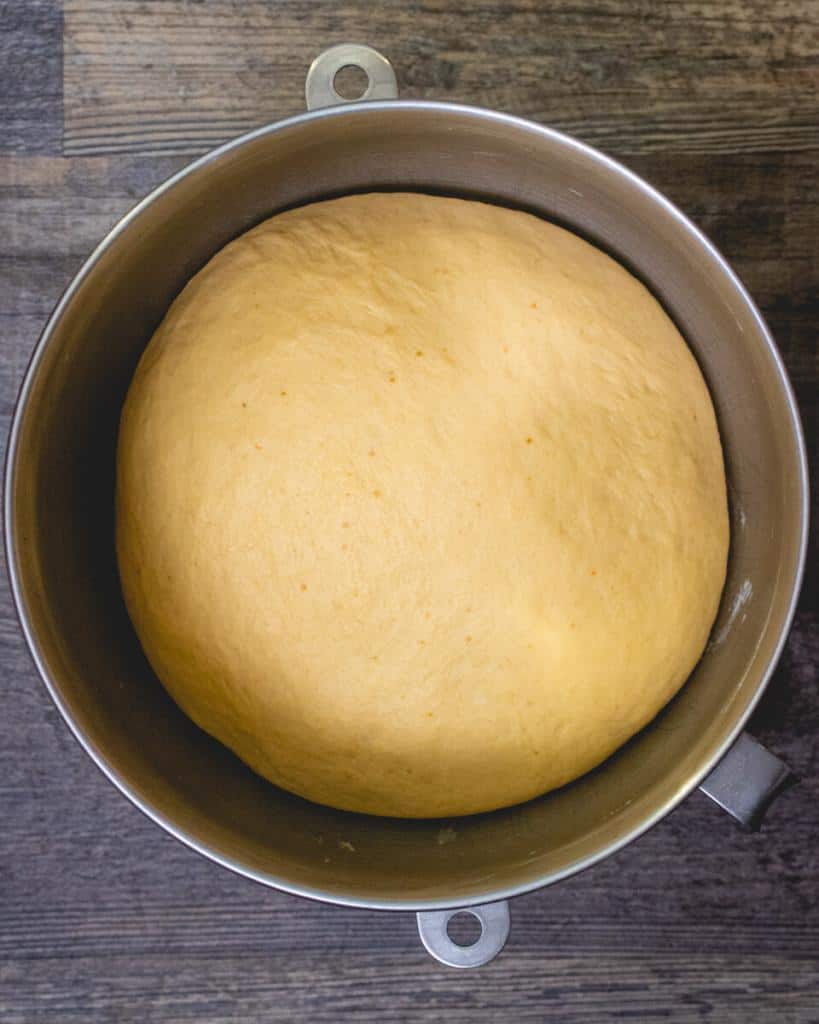
Step 5: Divide the Dough into Strands
Turn the risen dough out onto a clean surface. You can use a small amount of flour if necessary to keep the dough from sticking, but avoid using too much; it will be hard to get smooth even strands if you’re working with too much flour.
Divide the dough into even pieces depending on how many strands you want your braid to have. I typically divide into 6 pieces (using a digital scale for the most precision).
Flatten each piece into a rectangle, then roll it to form a log. Roll this with your palms on the counter to lengthen it to the length specified in the next section (based on how many strands for your braid). Taper the ends using your palms.
Step 6: Shaping the Challah
My favorite shape for the loaf is a 6-strand braid. There is a bit of a learning curve, but the payoff is a really beautiful and impressive loaf! I’m sharing the tutorial I used to learn the technique here on the left. On the right is a tutorial for a round shape for Rosh Hashanah.
Step 7: Let the Loaf Rise
Once your loaf has been braided, transfer it to a lined baking tray and brush it with an optional vegan egg wash substitute (1 tbsp soy milk whisked together with 1 tbsp agave or maple syrup).
Allow it to rise for another 45-60 minutes, until puffy. It’s ready to bake when you poke the dough and the indentation remains.
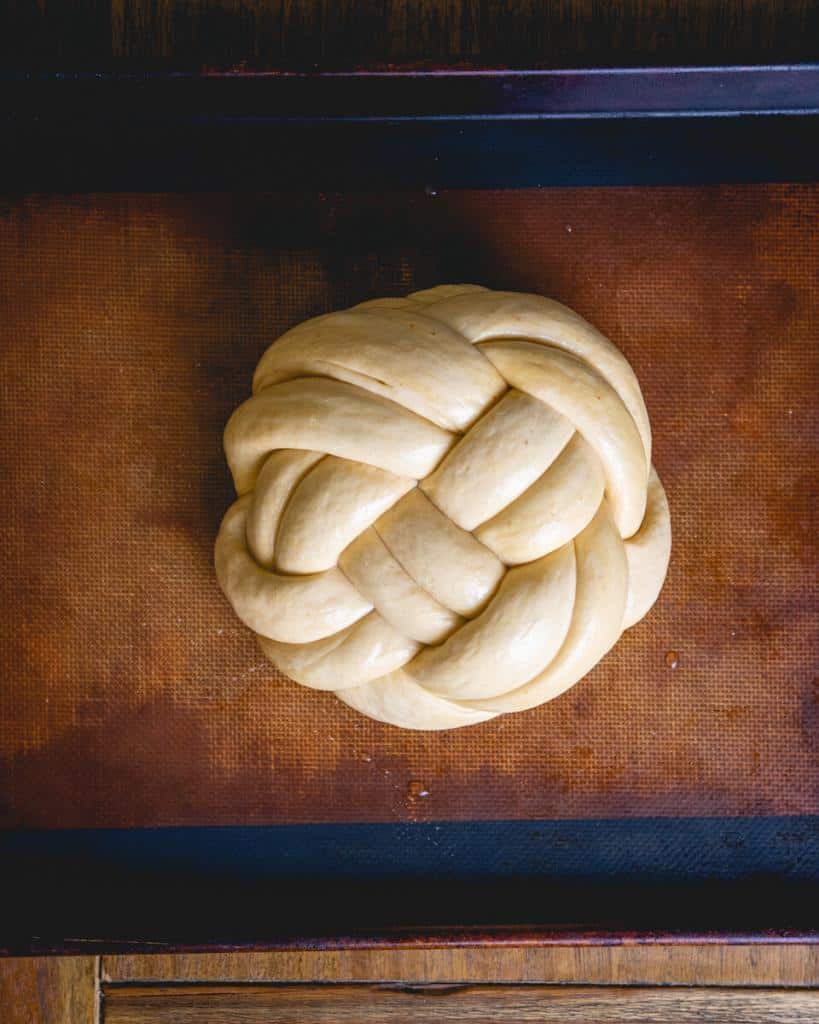
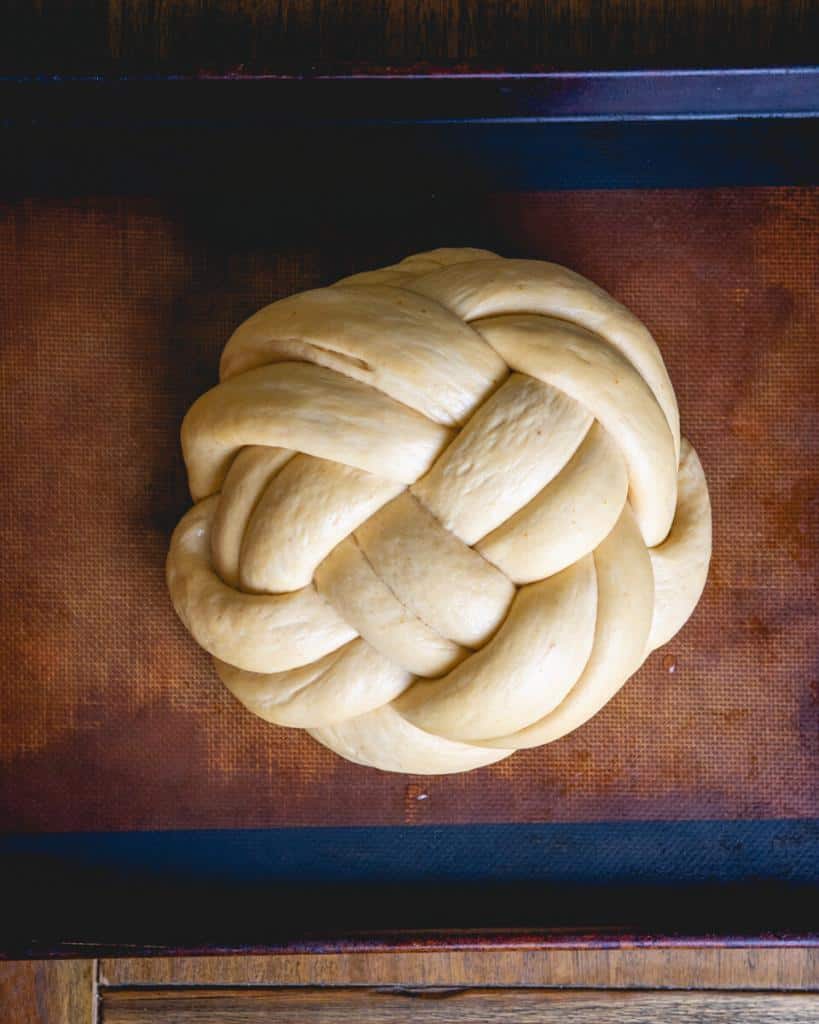
Step 8: Bake
Brush the loaf with another layer of egg wash substitute, then bake for 35-40 minutes. Check the bread at the 20 minute mark and again at the 30 minute mark. If it looks like it’s browning too quickly, tent it with aluminum foil for the remainder of the cook time.
Step 9: Allow to Cool
It’s best if you can allow the bread to cool completely before slicing (even though I know it’s tempting to dig right in). The dough keeps cooking during this time and sometimes if you cut it while it’s still hot, the texture can be gummy. I recommend waiting till it’s cool, and then lightly toasting a slice if you prefer to eat it warm.
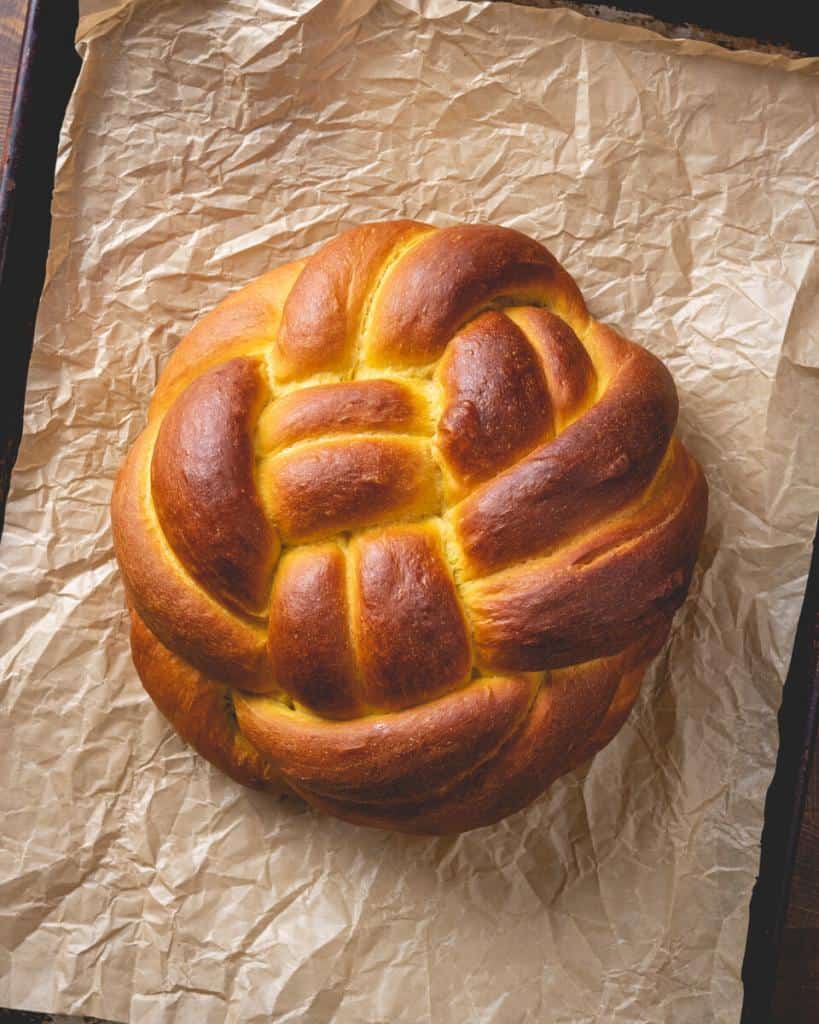
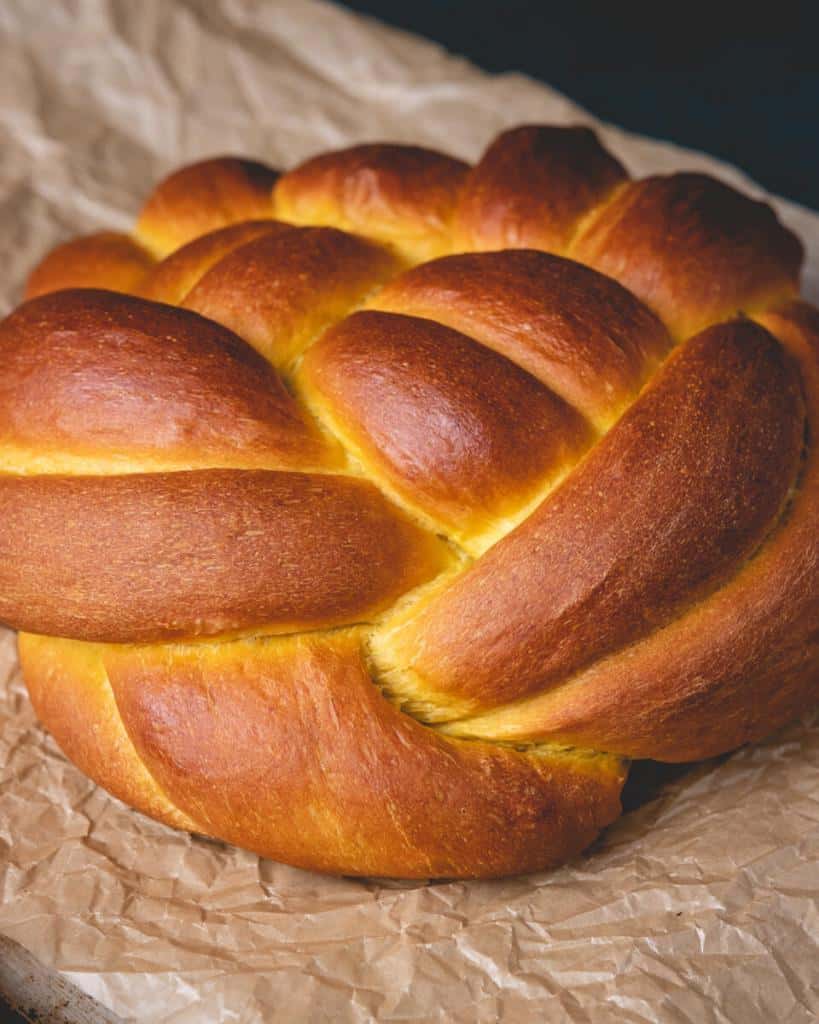
How to Store Vegan Challah
This bread is best if eaten within the first 2-3 days, but it will keep for up to 5 days at room temperature if you wrap it or keep it in a breadbox or other sealed container.
If you think you might not be able to eat it that quickly, I recommend cutting the loaf in half and freezing one half. It will keep in the freezer for up to 3 months.
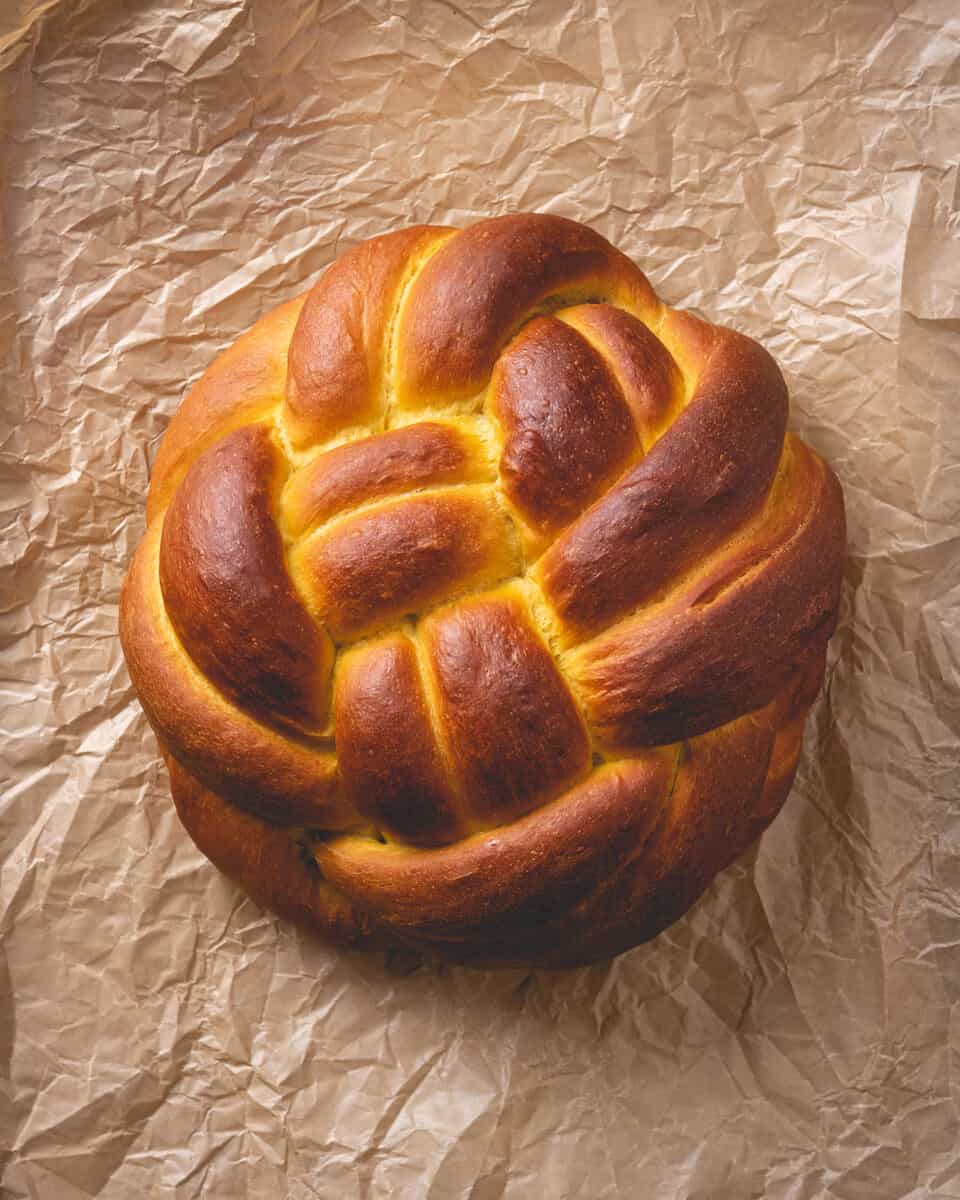
Vegan Challah
Ingredients
- 1 cup lukewarm water ~110°F
- 1 .25 oz package active dry yeast (2 1/2 teaspoons)
- 1/4 cup vegan butter softened
- 1/4 cup brown sugar
- 4 – 4 1/2 cups 480g bread flour (see notes)
- 1 1/2 teaspoons salt
- 1/3 cup sweet potato purée see notes
Instructions
- In the bowl of a stand mixer, sprinkle yeast over lukewarm water. Allow it to proof for about 5 minutes, until foamy.
- Add in sugar, softened vegan butter, and sweet potato purée and whisk or stir by hand to combine.
- Add in 4 cups bread flour and salt. Fit the stand mixer with the paddle attachment and mix on medium speed until the dough comes together in one rough piece.
- Switch to the dough hook attachment and knead on medium speed for 8-10 minutes. The dough will go from shaggy to smooth and elastic. It should be a little tacky but should easily clear the sides of the bowl. If the dough seems excessively sticky or wet, add in extra bread flour 1 tbsp at a time, kneading on medium speed between additions. (How much you’ll need can vary depending on factors like humidity and the protein content of your specific brand of flour.)
- Lift the dough out of the bowl and form it into a ball. Drizzle a little bit of oil in the bowl, then place the dough back into the bowl and turn it over to coat it with the oil.
- Cover the bowl with a clean, damp kitchen cloth and allow to rise in a warm place until roughly doubled in size. This will take about 1 hour on average, but if your kitchen is particularly cold it can take up to 2 hours.
- Turn dough out and form it into your desired shape. You can do a simple 3-strand braid, or scroll to the “Shaping the Challah” section in the blog post for more ideas.
- When forming the strands, divide the dough into the required number of pieces. (I like to use a scale for accuracy.) Then flatten each piece into a rough rectangle, and then roll it up like a cigar. Then roll each piece out using your palms, into a long strand, tapering the ends. This is similar to shaping a baguette.
- Note: Avoid using too much flour on your work surface when rolling out the strands. You can use a small amount to keep the dough from sticking to the surface or your hands, but if you use too much, it will be hard to shape your strands cleanly. We want the dough to be able to stick to itself when you roll it into strands. Generally if the dough is the correct texture, you should be able to roll it out on a clean surface without it sticking.
- Once the loaf has been shaped, transfer it to a baking tray lined with parchment or a silicone baking mat. You can brush it with a vegan egg wash substitute if you like (see notes). Then allow it to rise for 30 minutes to 1 hour. This will vary depending on the temperature in your kitchen. We don’t need the loaf to double in size, but we want it to become puffy enough that if you poke it with a finger, the indentation remains. If it springs back quickly, it needs more time.
- Start to preheat your oven to 375°F when the loaf is almost ready to bake.
- If using, brush the dough with another layer of egg wash substitute. Try not to drip extra on the tray, as the sugars in it tend to burn.
- Bake the loaf for 35-40 minutes. Check on it at the 20 minute mark. Especially if you used the egg wash substitute, you may find it is starting to get a bit dark. If this is the case, tent it loosely with a sheet of aluminum foil so it can continue to bake without browning excessively. The bread is ready when it’s evenly golden brown and sounds hollow when tapped on the bottom.
- Remove the dough from the oven. Transfer it to a cooling rack if you have one, and allow it to cool to room temperature. Bread continues to cook as it cools, so it’s generally not recommended to cut into it while it’s still steaming hot. This tends to give it a gummy texture.

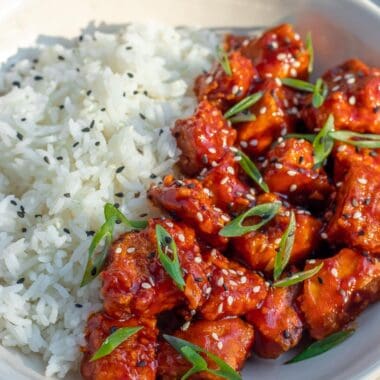
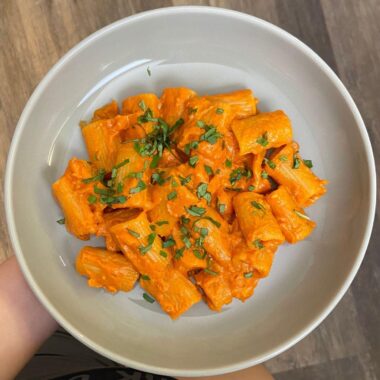

Any chance you have tried this with gluten-free flour? Am I just dreaming?
Thanks!
Hi! I’m so sorry to be seeing this comment so late, but I thought I’d answer for future readers. I haven’t experimented much with gluten-free flours and yeast-leavened doughs, unfortunately. I did a quick search and it seems most gluten-free challah recipes rely on the protein structure of eggs, plus added psyllium husk to achieve the fluffy texture and rise. I may do a little research/experimentation and try to share gluten-free bread options in the future!
This turned out delicious! Will absolutely make again.